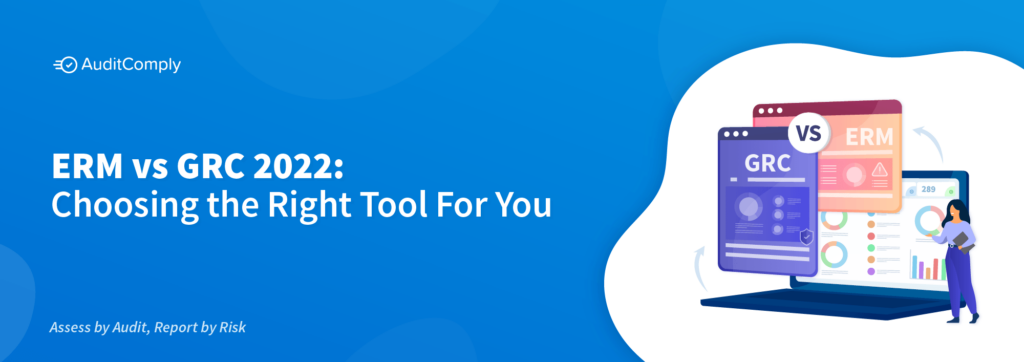
A rapidly changing business landscape signifies an organization will face a variety of risks throughout their lifetime. However, drawing similarities from ancient Chinese philosophy, it’s the mentality towards risk that can determine survival. Risk and opportunity. Yin and Yang. Good and bad. Two contractive forces that are complementary and interconnected. Uncovering opportunity and transforming a culture opposed to risk is never easy but with the right toolset, your organization can move away from simply surviving to thriving in these uncertain times.
While Enterprise Risk Management (ERM) and Governance, Risk and Compliance (GRC) tools are the answer to the same problem, their approach is vastly different. Choosing the right toolset for you will dramatically strengthen your strategic foresight. AuditComply’s approach to Risk Management is about breaking away from traditional silos, pushing the limits of interconnectedness across Governance, Risk & Compliance functions. Using unique data capture techniques and automation to connect and listen to all organizational events likely to influence our customer’s risk status, from Internal Audit to their Supply Chain. Providing past, present and future insights to help customers thrive in the age of uncertainty.
Interested? Book a demo with us today and learn more about how AuditComply can be the solution you need to navigate complex regulations, avoid disruption and build a more risk intelligent enterprise.
What is Governance, Risk and Compliance (GRC)?
GRC refers to a strategy for managing an organization’s overall governance, enterprise risk management and compliance with regulations. You can view GRC as an approach to break away from traditional departmental silos, aligning multiple business units with the overarching business strategy, all while effectively managing risk and meeting internal/external compliance requirements. With a GRC Management platform you can expect to unite data across Risk, Internal Audit, Third-Party/Supplier, ESG, EHS, Quality Management and more. The right GRC Management tool will bring a lot of benefits to your organization: Improved visibility & management, more optimal resource allocation & investment, elimination of silos, workflow customization & automation, better data and security management, real-time reporting & monitoring and more.
Governance is a purposefully broad term, a set of rules, policies and processes in place to guide corporate behaviour. It captures every aspect of the management function, from action plans, assessments and internal controls, to performance management. The Governance function is designed to ensure the organization meets and exceeds its objectives.
Enterprise Risk Management falls under the umbrella of GRC and is a set of processes to identify, assess, mitigate and manage threats. ERM will adopt a common framework designed to determine exposure to risk across a range of business units for example, Cybersecurity, Financial, Operational, Reputational and so on. Allowing the organization to better understand their appetite and tolerance in line with their objectives and operating environment. Internal audit also plays a vital role in ERM as an organization’s Risk Register will rely on information fed from internal audits and risk assessments.
Compliance involves meeting a set of stated requirements. These requirements could be an internal policy, quality standard or regulation. For example, a Food Manufacturer operating in the United States must comply with food safety laws enforced by the FDA or a healthcare company must comply with HIPAA. Audit Management plays a vital role here, providing assurance to leadership on program performance.
What is Enterprise Risk Management?
As mentioned above, Enterprise Risk Management can be defined as a subset of GRC, encompassing all areas relating to an organization’s exposure to risk. For example, Cybersecurity, Financial, Regulatory, Operation, Strategic, Governance, Commercial and more. ERM will usually adopt a common framework, providing a quantifiable approach to:
Identifying risk events that could be a threat or opportunity
Recording and assessing all risks, scoring them by likelihood and impact
Developing a strategy to mitigate and respond/control identified risks
Continuous monitoring and management of risks within the established risk appetite
ERM is about understanding, identifying, analysing and assessing risks to ensure the organization can achieve its objectives. The goal of an ERM solution is to encourage the adoption of an enterprise-wide risk culture. A dedicated ERM tool will streamline risk identification and mitigation activities, aligned with the organization’s changing requirements and landscape.
Making Your Decision
The tool your organization introduces will be determined by your overall objectives and requirements. As a reminder, ERM is a subset of GRC; GRC goes beyond traditional risk management, offering all the ingredients you need to advance your Governance, Risk & Compliance programs in line with your business objectives and overall strategy. There is no doubt, regardless of the toolset you decide to introduce, Risk & Audit technology is a must.
Book a demo with AuditComply today to learn more about how we can be the solution to help you navigate complex regulations, avoid disruption and build a more risk intelligent enterprise.
